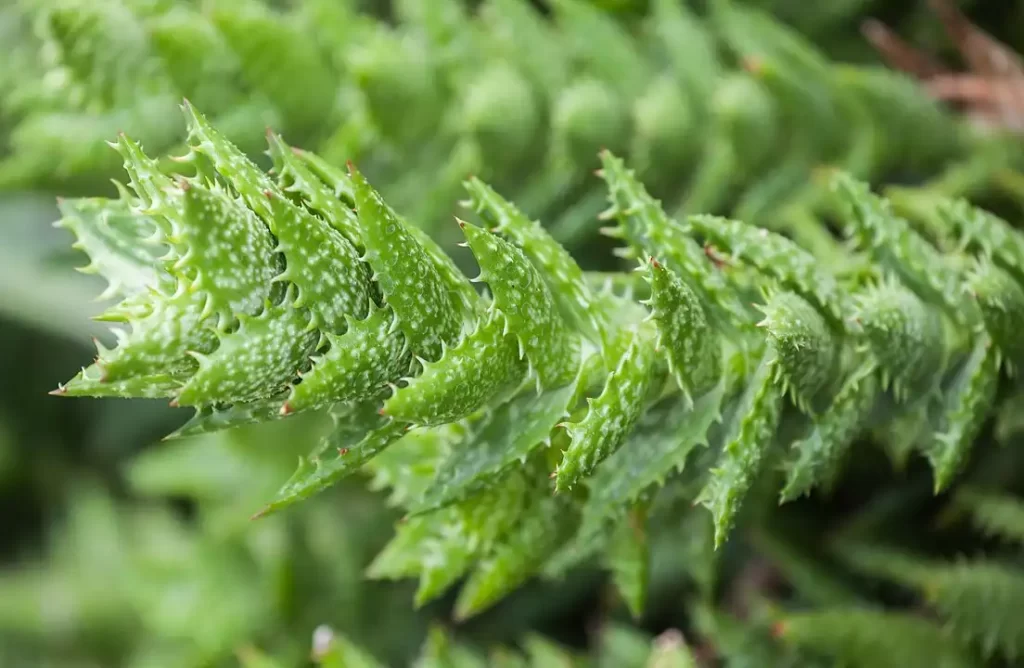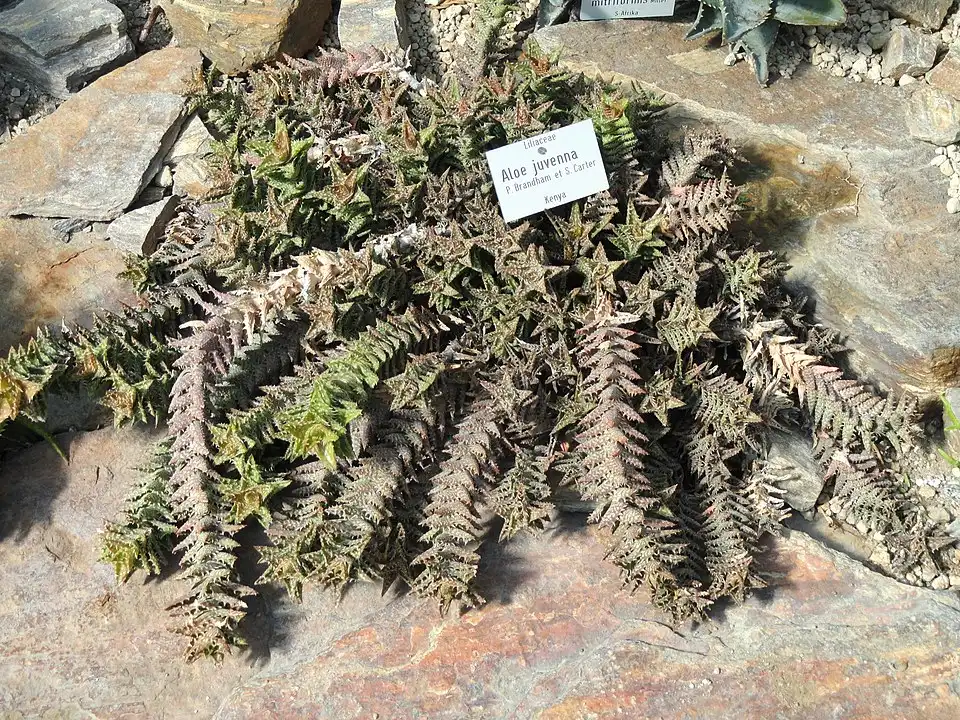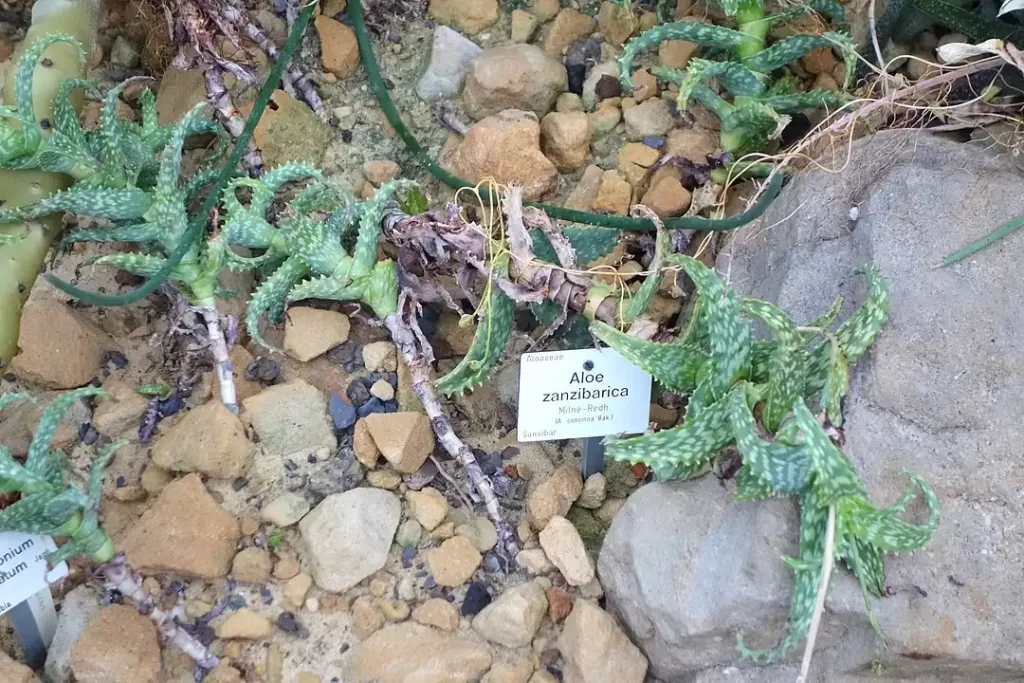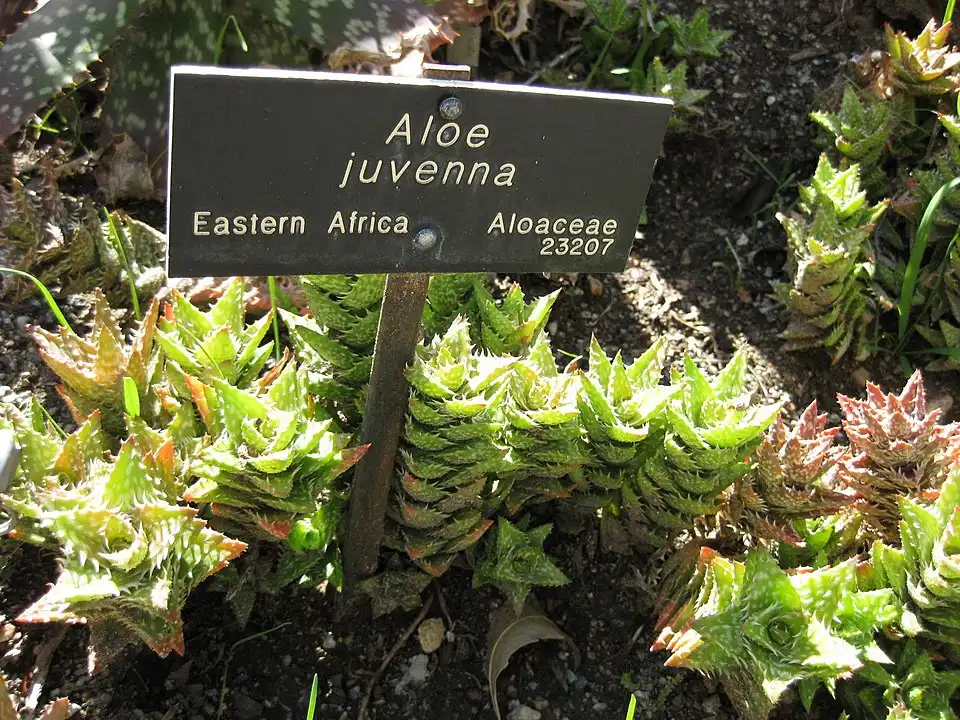One after hearing the name of the plant Aloe Juvenna, a plant genus that comes to the reader’s mind Aloe is the genus of plants famous for its large number of succulent plant species. A medically important plant Aloe Vera, true Aloe is also included in this genus.
The total number in this genus may exceed 550 species. Almost all plants are used by pharmaceutical industries to make useful healthcare products.

The term in the species name is Juvenna which means small in size. This was an early name provided by local people of East Africa because it was comparatively small in size as compared to other members of the genus Aloe. As per its small size, the Aloe Juvenna was made its scientific name in 1979’s[1]Oda, B.K. and B.A. Erena, Aloesof Ethiopia: A Review on Uses and Importance of Aloes in Ethiopia. Int J Plant Biol Res, 2017. 5(1): p. 1059. Read.
This plant is not common on random grasslands and around the globe. It has a limited location in the high tropical rainforests of Kenya (specifically South Kenya), Africa. It is observed that the native areas for the extensive growth of these small succulent plants are the Rocky Mountains.
If we observe the main physical characteristics of the plant, small compacted leaves around its small stems and branches are seen. The leaves are small and have a particular triangular shape as shown below.
Aloe Juvenna is about its number of sets of chromosomes. Mostly its subspecies and cultivars have tetraploidy which means its cell has double the number of sets of diploid chromosomes. Plant Aloe Juvenna has a traditional and decent green color that most Aloe plants have with white mottling.

Aloe Juvenna might show red or bronze or a mixture of reddish bronze sometimes brown when being constantly exposed to long and high-intensity sunlight. It reaches the height of 2 feet and the bunch of stems that grow in the form of a rosette expands about 24 inches[2]DHIVYA, M., R. SANKARANAYANAN, and G.D. KUMAR, AJH. Asian J. Hort, 2016. 11(1): p. 131. Read.
Toxicity is not that much reported. Another reason for the aesthetic attraction of Aloe Juvenna is its heavy clusters of leaves on usually a single main stem. It is also famous for being very rare in its native place and is also a common house plant.
The leaves of Aloe Juvenna have spines or teeth at their margins so, it is recommended to handle them with care while pruning and planting. As the above picture shows, the plant is often bright green or lush green during proper sun exposure days of the year.
The stem of the plant is of succulent type and spiky ends are also characteristics of this species. Aloe Juvenna is added to different skincare products as it has a role in protecting skin from sunburns.
When bright sunlight for a longer time is exposed to Aloe Juvenna, leaves turn brownish and some darker shades and start dying as well. Aloe Juvenna is a plant often interpreted for being Aloe Squarrosa, but there is an obvious difference in the appearances between both plants.

Aloe Squarrosa has curved longer and larger leaves as compared to Aloe Juvenna. The flowering is not seen commonly and it flowers during summer or in the middle of summer. The flowers are small and orange-red.
Animals like horses or camels feeding on Aloe Juvenna do not show any kind of disease symptoms. Aloe Juvenna may act poisonous for cats and dogs. The sap is somehow able to cause skin allergies so, is handled with gloves and it is said to keep kids away to avoid contact[3]Novelli, M. and M. Meregalli, Notes from Members. The Cactus and Succulent Journal of Great Britain, 1982: p. 68-70. Read.
Propagation of Aloe Juvenna
Seeds are rarely available and have not been used to grow Aloe Juvenna because of its rarely growing small flowers. Natural propagation through seeds is not present in its native areas. Artificial propagation methods are mostly used for garden plants or house plants.
1. Offsets cutting
For artificial propagation, offset cutting is generally practiced around the globe. Offsets are baby plants and small plantlets naturally growing near to old mother plants. They are connected to the roots of the mother or main plants.
They are carefully separated from the mother plants using sharp sterile scissors. Roots are also carefully managed for further healthy growth. Make sure the offset you are choosing is the healthy one. Dig carefully around the offset before cutting and keep it in the pot having drain holes at the bottom.
Cover the plantlets with healthy soil rich with all necessary nutrients and water properly. It is good to keep offset cutting in the pot with exposure to sunlight during summer and full sun days. In winter, these pots of Aloe Juvenna can be treated as indoor plants having an appealing look[4]Bagnasco, J. and B. Reidmuller Jr, Succulents: Choosing, Growing, and Caring for Cactuses and Other Succulents. 2019: Cool Springs Press. Read.
2. Stem cuttings
Stem cutting includes cutting and planting healthy stems of Aloe Juvenna. For this, a healthy stem is selected and cut with the assistance of a sharp pair of scissors. A specific milky sap will start flowing.
To get rid of the flowing sap one is suggested to wash that plant’s cutting edge under a cold water tap. The sap will be removed and further, the stem is kept overnight. The dried stem cutting is settled into a pot having drain holes at the bottom. The roots develop earlier and the stem is checked for growing strong and healthy so that these can be planted in beds or the garden.
3. By division of Root Balls
For this mature plant is preferred to get healthy root balls. Root balls are structured near roots and are thick and full of stored sap. The process is performed with gloves on because the sap can create an allergy to the skin, mouth, and eyes if touched.
- Carefully dig to the roots.
- Select a healthy root ball to separate it from the plant with shears.
- It is recommended to handle sap with great care.
- Two pieces are cut from the root ball.
- Plant these root balls in the soil directly or plant them in the pots[5]Sung, C.K., The history of Aloe, in New perspectives on Aloe. 2006, Springer. p. 7-17. Read.
Diseases of Aloe Juvenna
Insect pests are more common in creating disease conditions and damage to the foliage of Aloe Juvenna. Notorious insect pests responsible for the destruction are mealy bugs and aphids. Aphids feed on sap. These insects are treated with cold water and customized insecticides.

Some other insects such as mites, thrips, and gall wasps cause low production of Aloe Juvenna. Two fungal species named (Phytophthora cinnamomi) and (Erysiphe Polygoni) also cause leaf spots and powdery mildew respectively.
A disease condition called aloe wilt is also associated with the species Aloe Juvenna. Watering should be done at proper intervals to avoid the majority of the fungal infection and cold water splashes from a garden hose are also important to get rid of insects.
Care of Aloe Juvenna
- Water Aloe Juvenna when the soil becomes completely dry. It is a succulent plant with thick stems and leaves so requires less water.
- Less watering may lead to browning of the lower leaves.
- The potted plant may dry earlier and require more frequent watering.
- One can add fertilizers mixed in water and apply those for the enrichment of the soil.
- It is also better to use customized soil called cactus potting soil.
- Regular re-potting is done to avoid plant diseases and decay of the leaves.
- Pruning or grooming is also used to make the plant more attractive. It helps to remove old, curved, and brown decaying leaves from the plant.
References
| ↑1 | Oda, B.K. and B.A. Erena, Aloesof Ethiopia: A Review on Uses and Importance of Aloes in Ethiopia. Int J Plant Biol Res, 2017. 5(1): p. 1059. Read |
|---|---|
| ↑2 | DHIVYA, M., R. SANKARANAYANAN, and G.D. KUMAR, AJH. Asian J. Hort, 2016. 11(1): p. 131. Read |
| ↑3 | Novelli, M. and M. Meregalli, Notes from Members. The Cactus and Succulent Journal of Great Britain, 1982: p. 68-70. Read |
| ↑4 | Bagnasco, J. and B. Reidmuller Jr, Succulents: Choosing, Growing, and Caring for Cactuses and Other Succulents. 2019: Cool Springs Press. Read |
| ↑5 | Sung, C.K., The history of Aloe, in New perspectives on Aloe. 2006, Springer. p. 7-17. Read |



